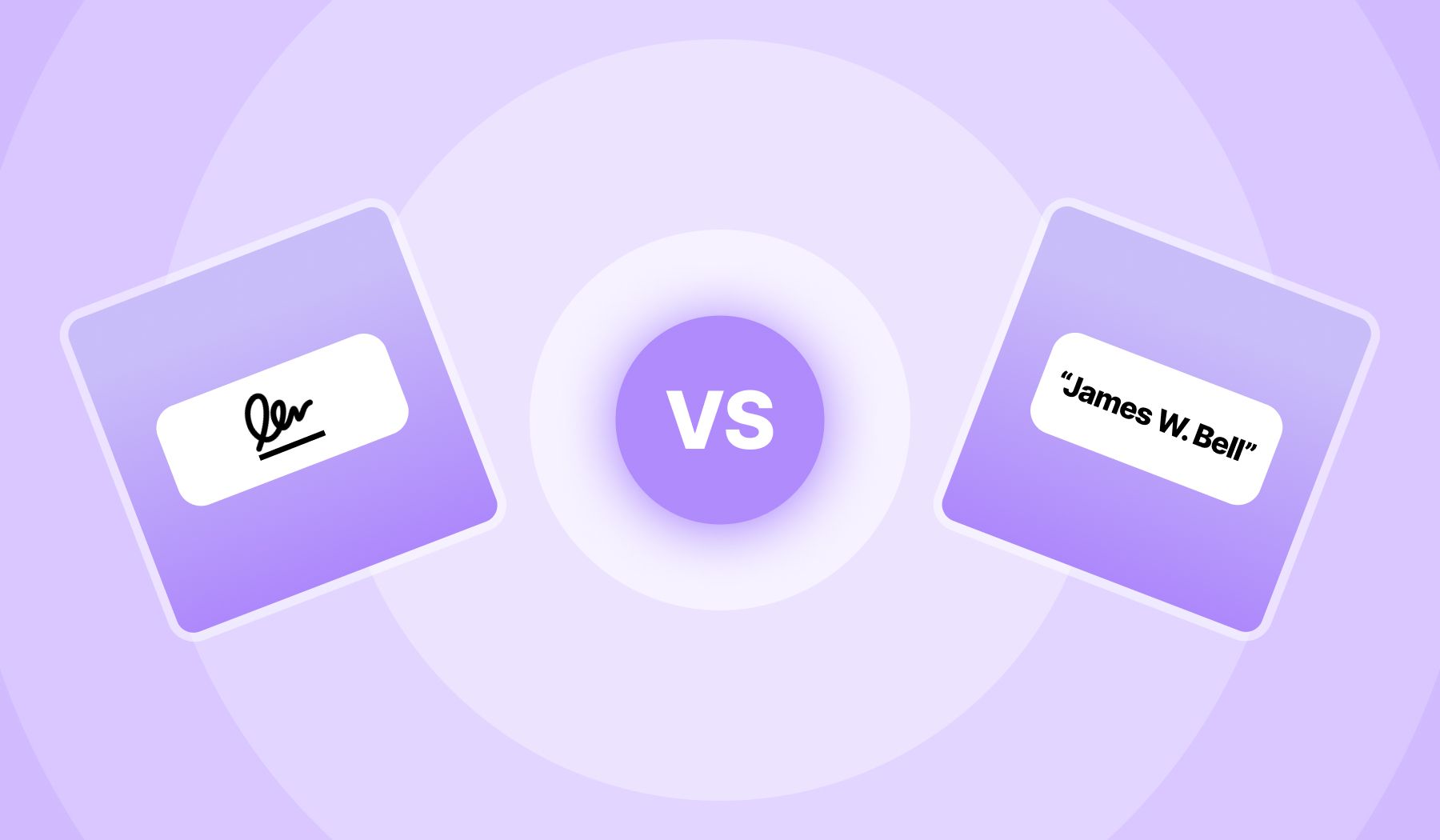Do Signatures Have To Be In Cursive? (Clarified, In 2 Min)

You’re probably in this situation.
- You’re about to sign something
- You’ve seen plenty of signatures that look like the ones below
- You have no idea whether they need to look like that or not

We’ve asked government officials, lawyers, bureaucrats, and academic professors: does your legal signature have to be in cursive for it to be valid?
The short answer is this: Wet ink signatures are likely to be cursive, but no, your signature does not have to be in cursive for it to be 100% legal — eSignatures can not be in cursive.
But there’s more to it… what matters then, if not whether it’s in cursive?
Wet ink signature? What’s that?
A wet signature is a handwritten signature written with ink on paper, used to authenticate documents.
We’ve written an in-depth analysis of how wet ink signatures are different from other types of signatures.
The short of it is this:
- If you draw your signature on a piece of paper, that’s usually called a “wet ink signature”.
- If you create your signature online, that’s usually called an “electronic signature”.
However, a wet ink signature can become an electronic signature, if you use it with a properly-built, 100% secure eSignature software such as SignHouse.
What makes a Signature?
It all depends on whether we’re talking about a digital or physical document.
Physical documents
- Validity of Physical Signatures: The authenticity of a signature on a physical document is determined by its similarity to the “original” signature.
- Identifying the Original: Determining which signature is the original often requires expert services, especially in legal situations.
- Need for Expertise: Experts needed to verify signatures possess specialized, esoteric knowledge.
- Importance of Reputation: These third-party experts must also have a reputable standing in the industry.
Digital documents
On the other hand, the digital realm presents a couple of advantages:
- Signatures are 10x easier to be attributed
- As per the eSignature (2000) and UETA (2000) Acts passed by the US Government, alongside other requirements (explained in-depth by us here), one of them is this: “Attribution. The signature has to be uniquely identified to the signee and only linked to them”
- Using an electronic signature software such as SignHouse automatically handles that, as such apps easily attribute signatures with identifiable details (e.g. account information, location, IP, etc)
- Another requirement for a digital signature to be valid: “Retention. The documents must be stored for future reference, available to be viewed, reviewed, edited, etc. by both parties”
- SignHouse takes care of this aspect as well.
Conclusion: Do signatures have to be in cursive?
So… why did we relate to you these bits of information? What was the point of comparing physical docs signatures vs digital docs sigantures?
It all ties in together now: if you’re electronically signing, you can understand now why your signature doesn’t have to be in cursive at all. Cursive or not, that’s not what defines its validity.
- However, on the other hand, on a physical document, you might want to use cursive, as it makes the signature more… valid, so to speak.
- What we mean by that: your signature will be harder to replicate, thus making it more bulletproof.
The short answer we started from was that it doesn’t have to be in cursive. And we’re still at the same conclusion.
But on a physical document you might want to write it in cursive.
Though, on a digital document? No need for all that.
FAQs
Can a signature be typed?
Your signature 100% works and is 100% legal if it's typed, if you're using an electronic signature software!
Why? It's validity is given by other factors:
- As per the eSignature (2000) and UETA (2000) Acts passed by the US Government, alongside other requirements (explained in-depth by us here), one of them is this: “Attribution. The signature has to be uniquely identified to the signee and only linked to them”
- Using an electronic signature software such as SignHouse automatically handles that, as such apps easily attribute signatures with identifiable details (e.g. account information, location, IP, etc)
- Another requirement for a digital signature to be valid: “Retention. The documents must be stored for future reference, available to be viewed, reviewed, edited, etc. by both parties”
- SignHouse takes care of this aspect as well.
Therefore, typing your signature makes it valid, due to the aspects that an eSignature software handles for you.
Can a signature be your initials?
Yes, it absolutely could be! Why: your electronic signature is not defined by how it looks. It could even be a glyph.
Your signature's validity is given by other aspects, as explained in this article of ours:
- As per the eSignature (2000) and UETA (2000) Acts passed by the US Government, alongside other requirements (explained in-depth by us here), one of them is this: “Attribution. The signature has to be uniquely identified to the signee and only linked to them”
- Using an electronic signature software such as SignHouse automatically handles that, as such apps easily attribute signatures with identifiable details (e.g. account information, location, IP, etc)
- Another requirement for a digital signature to be valid: “Retention. The documents must be stored for future reference, available to be viewed, reviewed, edited, etc. by both parties”
- SignHouse takes care of this aspect as well.
So yes, your signature can be your initials!
Can I sign with a signature that’s not cursive?
Signing with a non-cursive signature is ok! If we're talking about digital documents, the signature will be validated by identifiable details that are separate from how it looks — that is taken care of by an eSignature software such as SignHouse.
If we're talking about physical documents:
- You could sign with a signature that's not in cursive
- You'll likely not want to do that, as it could be replicated.
- Our advice, however, is to stick to digital signatures!
Does a signature have to be your full name?
That could be the case too. Remember: your signature's validity is given by the following:
- As per the eSignature (2000) and UETA (2000) Acts passed by the US Government, alongside other requirements (explained in-depth by us here), one of them is this: “Attribution. The signature has to be uniquely identified to the signee and only linked to them”
- Using an electronic signature software such as SignHouse automatically handles that, as such apps easily attribute signatures with identifiable details (e.g. account information, location, IP, etc)
- Another requirement for a digital signature to be valid: “Retention. The documents must be stored for future reference, available to be viewed, reviewed, edited, etc. by both parties”
- SignHouse takes care of this aspect as well.
So whether your signature is your full name or not, it just has to be validated through an eSignature software. That's why, for instance, signatures created through Apple Notes, through your iPhone, are not legally recognized.
Feel free to read the full analysis of why your full name is not 100% required in a signature in this article.








